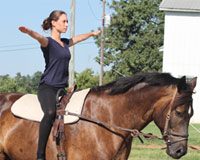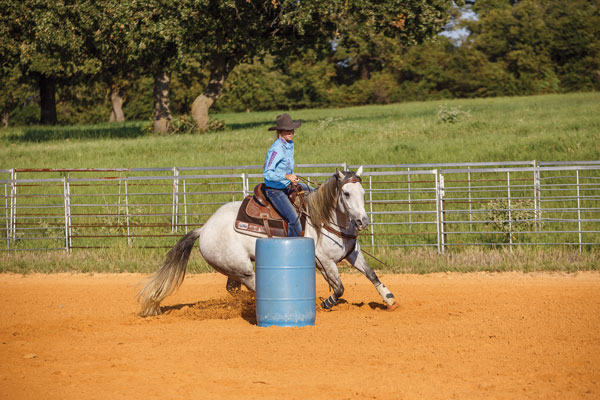
The winner at barrel racing horse riding isn’t solely the run with the fastest possible time. Today’s barrel racing competitions include five divisions, with placings for each one. The fastest time of all is first place in 1D. A half-second slower time is first place in 2D, and so on. This means it’s easy to find a spot where you can do well and be competitive. You can also work to improve into the next division, moving up from the 5D to 4D, all the way up to 1D.
“Your horse can only run as fast as he can run, but running a good and correct pattern is better than running fast all over the arena,” Wimberley says.
Focus on the Fundamentals
Before going faster, Wimberley advises mastering the basics. These include:
◆ Do your slow work, and master it before moving on.
◆ Guide your horse to the same pocket on each barrel every time. (Read Wimberley’s advice in “Find Your Pocket” in the January/February 2021 issue of Horse Illustrated.)
◆ Rate your horse at the same spot every time.
◆ Pick your horse up to turn the barrel at the same spot.
“You can add speed at any time, but when the pattern is not correct, you have to go back to the fundamentals,” Wimberley says. “Remember, correct repetition is key.”
Even after you add speed, go back to your slow work—a walk, a jog or a lope, and go around the barrels as correctly as possible in the same path as you would at a run.
Don’t Rush It
Wimberley says riders ratcheting up the speed before their skills are ready is one of the biggest mistakes she sees.
“If you don’t have enough training and run a horse too fast before you’re ready, you might get into a much higher division once or twice (Like going from a 5D to a 3D), but you really will go backwards after that,” she cautions. “You have to go through the steps.”
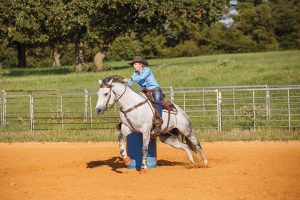
Adding Speed
Make sure you can still find the spot at the barrel where you slow just a bit and begin your turn—the “rate spot.” If you’re going too fast to nail the rate spot, then you need to reduce your speed until you can do this consistently.
“It’s like driving a car: you can only push the gas so far until you have to press the brake to turn on a curve,” Wimberley says. “A lot of times we can forget where the brakes are. Each horse has its own spot where you need to rate, and that could change depending on how fast you’re going.”
You’ll make mistakes as you’re barrel racing horse riding and learning where to rate at a higher speed, says Wimberley. But remember to pick up your reins and cue correctly with your body to help your horse make the turn. You will learn where your spot is with some trial and error.
Look for your horse to be able to respond to your cues and run the pattern correctly, no matter the speed, says Wimberley. You want to stay in control, even at the faster pace.
“If you are precise with your cues on the pattern, your fundamentals are probably there,” Wimberley says. “So add speed gradually. If the speed gets too much for the horse, he’ll tell you, and you can go down in speed the next time. You’ll learn the feel of when you go too fast, or when you’re ready to go faster—and how much speed you can add.”
Don’t neglect the slow work though, says Wimberley. Don’t run the pattern at top speed all the time. Work on drills and portions of the pattern at home to keep your horse responsive and in the right mindset.
Here are a couple of drills Wimberley does with her horses at home to fine-tune speed and precision.
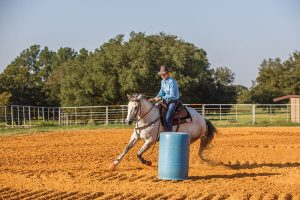
One Barrel
Many times, Wimberley will work her horses at home on just one barrel, focusing on making it as correct as possible.
“If I’m working a right-handed barrel, I’ll just work that right hand turn for the day,” Wimberley says. “There’s a lot I can do: set and rate, pick up my reins, and go the same distance around the turn.”
You can practice upping your speed on that one barrel—Wimberley says some horses train better when you just work the one, rather than a whole pattern.
“They can get excited when there’s three barrels in the arena, but when there’s just one, you can work on mastering it,” Wimberley says. “It’s really hard on a horse to run three barrels every day. They can get tired of it.”
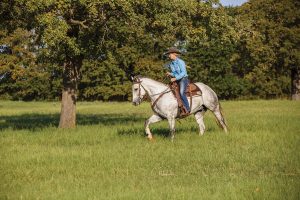
Circles
Guide your horse in a circle and try adding speed to that circle without your horse falling out of shape. Wimberley does this in the arena, and also in the pasture, and she’ll even lope around a tree as the center of the circle.
“When you lope a circle, a bigger circle is always easier to master than a smaller one,” Wimberley says. “I would first pick up a 10-foot circle and go down to about a 6-foot circle. Work to keep your horse moving forward at a lope, keeping the circle equal distance around. Remember to stay big first, master that, then work to make it smaller. If it gets too hard for you, go back to the bigger circle.”
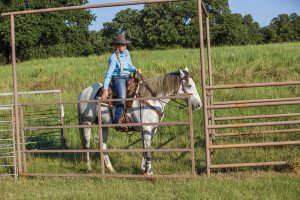
Opening a Gate
You can work on your horse’s responsiveness by opening and closing a gate on your barn’s property, says Wimberley. This is a task she puts her horses through every time she rides.
“If a horse doesn’t open the gate correctly, they’re probably not going to do the barrel pattern correctly,” Wimberley adds. “All of these things carry over for me.”
Keep it slow and steady to avoid agitating your horse. Taking one step at a time is the best way to achieve your goals.
This article about barrel racing horse riding appeared in the March 2021 issue of Horse Illustrated magazine. Click here to subscribe!
MEET THE TRAINERCheyenne Wimberley of Stephenville, Texas, has been a barrel racer |




